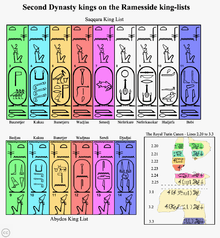Second Dynasty of Egypt

The Second Dynasty of ancient Egypt (or Dynasty II, c. 2890 – c. 2686 BC[1]) is the latter of the two dynasties of the Egyptian Archaic Period, when the seat of government was centred at Thinis. Save for the time of its last ruler Khasekhemwy, it marks one of the most obscure periods in ancient Egyptian history.
Though archaeological evidence of the time is very scant, contrasting data from the First and Third Dynasties indicates important institutional and economic developments during the Second Dynasty.[2][3]
Rulers
The names of the actual rulers of the Second Dynasty are in dispute. For the first five pharaohs, the sources are fairly close in agreement. Known rulers, in the History of Egypt, for this dynasty are as follows:
| Name | Years Reigned |
|---|---|
| Hotepsekhemwy | 38 |
| Nebra (maybe identifiable with Weneg)[4] | 10–14 |
| Nynetjer | 40 |
| Senedj (maybe identifiable with Horus Sa[5]) | 20 |
However, the identity of the next two or three rulers is unclear. We may have the Horus name or Nebty name and their birth names for these rulers, yet they may be entirely different individuals or they may be legendary names, we may never know. On the left are the rulers most Egyptologists place here and on the right are the names that ultimately come from Manetho's Aegyptica:
| Proposed Ruler | Manetho's List |
|---|---|
| Seth-Peribsen | Kaires |
| Nepherkheres | |
| Sekhemib-Perenmaat | Sesokhris |
With the last ruler, we return to an agreement:
| Name | Years Reigned |
|---|---|
| Khasekhemwy | 17–18 |
Although Manetho states the capital was at Thinis, the same as during the First Dynasty, at least the first three kings were buried at Saqqara, suggesting the center of power had moved to Memphis. Beyond this, little can be said about the events during this period as the annual records on the Palermo stone only survive to the end of the reign of Nebra and for parts of Nynetjer's. One important event possibly happened during the reign of Khasekhemwy. Many Egyptologists read his name, Khasekhemwy, as "the Two Powers arise"; possibly commemorating the union of the Upper and Lower Egypts.
References
- ↑ Shaw, Ian, ed. (2000). The Oxford History of Ancient Egypt. Oxford University Press. p. 480. ISBN 0-19-815034-2.
- ↑ Romer, John (2013) [2012]. "Chapter 18 — The Lost Dynasty". A History of Ancient Egypt. Volume 1. London, ENG: Penguin Books. pp. 221–22. ISBN 978-1-8-4614377-9.
Whatever else was taking place at the court of the Second Dynasty of kings, it is clear that the fundamental institutions of pharaonic government, its systems of supply, not only survived throughout that century and a half, but flourished to the extent that, when the kings emerge into the light of history again with the pyramid builders of the Third Dynasty, the state on the lower Nile was more efficient than it had ever been: that there was, therefore, strong institutional continuity.
- ↑ Bard, Kathryn A. (2002) [2000]. "Chapter 4 — The Emergence of the Egyptian State". In Shaw, Ian. The Oxford History of Ancient Egypt (paperback) (1st ed.). Oxford: Oxford University Press. p. 85. ISBN 978-0-19-280293-4.
There is much less evidence for the kings of the 2nd Dynasty than those of the 1st Dynasty until the last two reigns (Peribsen and Khasekhemwy). Given what is known about the early Old Kingdom in the 3rd Dynasty, the 2nd Dynasty must have been a time when the economic and political foundations were put in place for the strongly centralized state, which developed with truly vast resources. Such a major transition, however, cannot be demonstrated from the archaeological evidence for the 2nd Dynasty.
- ↑ Kahl, Jochem (2007), "Ra is my Lord", Searching for the Rise of the Sun God at the Dawn of Egyptian History, Wiesbaden.
- ↑ Von der Way, Thomas (1997), "Zur Datierung des "Labyrinth-Gebäudes" auf dem Tell el-Fara'in (Buto)", Göttinger Miszellen, 157: 107–11.
| Preceded by First dynasty |
Dynasty of Egypt c. 2890 – 2686 BC |
Succeeded by Third dynasty |
